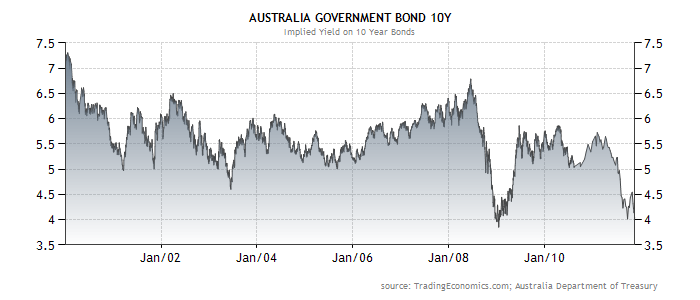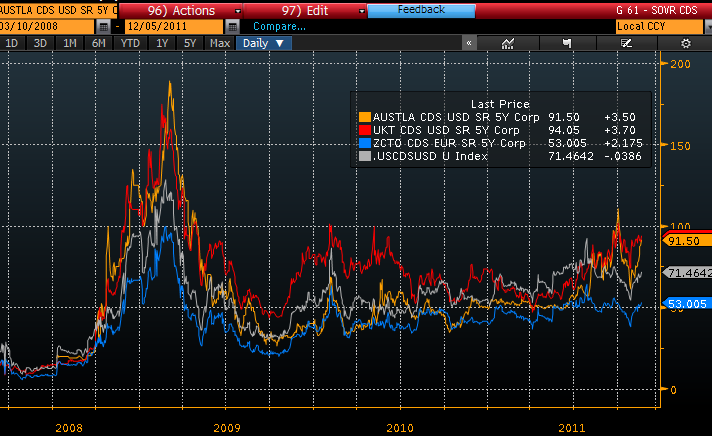Oh yes, it’s on. According to Ralph Norris, whose exit from CBA will have to register alongside that of Alan Moss from Macquarie for propitious timing, GFCII is here. From the SMH:
OUTGOING Commonwealth Bank chief executive Ralph Norris has warned that the European debt crisis has entered a dangerous phase, likening the current turmoil to the global financial crisis of three years ago.
Mr Norris said global money markets ”effectively froze” this week as Germany failed to sell the entire stock of €6 billion ($8.2 billion) worth of long-term bonds.
His comments came as the leaders of the euro zone’s key economies, France and Germany, met in France overnight to resolve differences over how to handle Europe’s debt crisis.
But Mr Norris, who retires next Wednesday after more than six years in the role, cautioned that credit-crunch conditions were returning, which is threatening to choke off funding for banks around the world.
”This has potential to be significantly worse than the Lehman Brothers collapse and the subprime crisis because now we are talking about nation states,” Mr Norris told BusinessDay.
”If you have a situation like you had today, where markets had effectively frozen, then it doesn’t matter how good your name is, you are not going to be able to access markets,” Mr Norris said. ”As of today, no banks could access these markets.”
Westpac boss Gail Kelly also expressed fears about the fragile situation and urged Europe’s regulators to get on top of the crisis.
”What’s happening in Europe is a major concern and not improving. The various authorities in Europe actually have the capacity to deal with these issues – I certainly wish they’d get on with it and do it,” she said.
And so “the softening” ramps up a gear. It began a couple of weeks ago, with dark rumors beginning to spread from bankers about Europe and funding costs. Now we have a moment to blame. It’s the failed German bond auction don’t you know! Which may hold some truth but neglects to mention that wholesale funding markets have been shut to the Australian banks for many months. We are setting up here, most definitely, for a renewal of the government guarantee to the banks wholesale funding. Why else are bankers doing this in the popular dailies? Gail Kelly earlier this week in The Oz, now Ralph Norris in Fairfax press. This is a message for the people. It’s their money that’s on the line.
Which brings me back to yesterday’s fantastic thread on my “Should we guarantee the banks now post?” Every Australian should read that thread. It’s smart, snappy and fired up about the choice that’s before us. I’m very proud to be a part of such media.
But, there was one thing that many commenters overlooked that is vital to understanding our present position. To some extent that may be my fault, the title of the post is a bit misleading. It should probably have been “shall we make the guarantee explicit now?” That’s the thing, you see. Like it or not, we already guarantee the banks wholesale funding. We just do it in implicitly, secretly. Nonetheless, both Moody’s and S&P have made it abundantly clear that that guarantee gives the banks a ratings boost, already.
There is, of course, $114 billion still outstanding from when the guarantee was last visible. The weird thing about it is, though, that these “contingent liabilities” don’t really show up in the pricing of government bonds. Here is a recent chart of Australia’s 10 year yield:

There is no obvious effect on the yields from the 2008 guarantee, which amounted to roughly 15% of GDP, in the yields. Let’s look instead at the more liquid and sensitive CDS market:

This is a chart of 5 year Australian sovereign CDS prices versus some other nations. As you can see, the price to insure against default in Australian government bonds exceeded both the US and UK in the GFC, despite their much worse problems, then fell back very much below and is now jumping again beyond the other Anglosphere nations.
This is no real surprise even without considering contingent bank liabilities. The US and UK issue bonds their own currencies and both are of sufficient magnitude and standing to allow quantitative easing, which can cap yields and credit risk.
Let’s see what a chart of Australian bank versus CDS prices can tell us:

Now that’s interesting. There’s a clear relationship but that could simply be put down to shifts in the credit cycle as interest rates rise and fall, as does credit risk. And, obviously, since the GFC, the spread between the cost to ensure against a sovereign default versus the cost to insure against a bank default has widened significantly. Perhaps this reflects a rerating of Australian sovereign debt in the past few years as the “dirty shirts” of other nations have become the benchmark.
But it’s equally hard not to conclude that the CDS market is under priced for a renewed sovereign guarantee of Australian bank debt.

